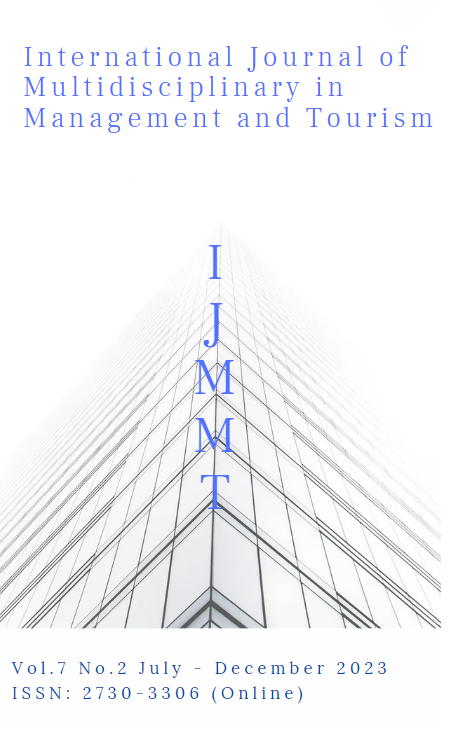Chinese Enterprise Overtime Working Problems and Its Solutions: Case of Jinan City, Shangdon Province, China
Main Article Content
Abstract
In the context of China's fast-expanding economy, extended working hours have become a hallmark of many corporate cultures. This practice, often labeled the "996" work regimen (9 a.m. to 9 p.m., 6 days a week), has increasingly come under scrutiny. Hence, this study aimed to: (1) examine the prevalence of overtime work in Chinese enterprises, (2) identify the challenges associated with excessive overtime, and (3) explore potential solutions. Our research focused on 15 employees from three private firms in the fields of software technology, metallurgy, and energy-saving investments, all located in Jinan, Shandong province. These participants were chosen for in-depth interviews, and data was collected via interview sheets. Subsequent content analysis revealed the following:
1. Overtime work is a widespread phenomenon in Chinese enterprises, particularly in major urban areas and certain sectors. Even though organizations outline tasks to be completed within regular work hours, employees frequently resort to overtime to meet job demands, due to reasons such as impending deadlines, client requirements, and overtime pay policies. However, the government has recently been advocating for balanced work hours and urging firms to enhance work environments to minimize overtime.
2. The challenges stemming from excessive overtime in Chinese companies include: 1) Adverse impacts on worker health, 2) Diminished life quality for employees, 3) Strained familial ties, and 4) Infringements on the legitimate rights of workers.
3. Potential remedies to address the overtime issue include: 1) Refining vocational and technical training systems, 2) Bolstering human resource management strategies, 3) Developing a comprehensive childcare framework, and 4) Ensuring proper protection of employee rights.
Article Details

This work is licensed under a Creative Commons Attribution-NonCommercial-NoDerivatives 4.0 International License.
References
Chen, Y. (2022, April 10). National Bureau of Statistics: The total current GDP in 2021 will be 11,49237 billion yuan. Beijing News. http://www.stats.gov.cn/english/PressRelease/202212/t20221227_1891279.html
Dehecai, C. (2023, April 06). Employees criticize mandatory “overtime" is a hot search topic. Do you know the legal red line on overtime? Beijing News. https://baijiahao.baidu.com/s?id=1762432076289658084&wfr=spider&for=pc&searchword&fbclid=IwAR0SqT0_ZUfDizetxjO6ufNnz2RGuh0sHBQ_cAAZpRcbsxsDc50uaqlhKUQ
Dembe, A. E., Erickson, J. B., & Delbos, R. G. (2005). The impact of overtime and long work hours on occupational injuries and illnesses: new evidence from the United States. Occupational and environmental medicine, 62(9) 588-597.
Huang, Z. (2013). Study on the phenomenon of involuntary and inefficient overtime work of employees. Hubei: Huazhong Agricultural University.
Jing, H. (2023, September 17). How does the labor contract law stipulate overtime hours. https://08yfyc.smartapps.cn/pages/zs/info/info?id=757775&_swebfr=1&_swebFromHost=baiduboxapp
Li, H., & Zhao, Z. (2021). Legal Ramifications of Unregulated Overtime in China. Beijing Law Review, 12(4), 330-345.
Li, Q., & Zhang, X. (2023). Corporate social responsibility controversy of "overtime culture": An analysis based on the phenomenon of enterprises praising high-intensity work. Journal of Economic Research, 4, 24-27.
Liu, L. (2019, April 06)."Work 996, sick ICU"! "996 work system" storm again. Zhejiang Youth Research Center. https://mp.weixin.qq.com/s?_biz=MzA4MjA1NjAzMQ ==&mid=2651109748&idx=2&sn=8b53efcf3d1384a75cba49f26b2cb93e&chksm= 847b9f44b30c1652774c9249f2e18f631d4e2064293da1694584960e00f9f8b4db 5dde2f506a&scene=27
Liu, M., & Yang, X. (2018). The Physical and Psychological Impacts of Overtime Work in China's Tech Sector. Journal of Occupational Health, 45(3), 210-220.
Shen, J. (2022). The Shift in Public Perception: Overtime Work in Modern China. Social Change in East Asia, 29(1), 15-29.
Wang, L., & Chen, Y. (2020). Economic Benefits and Hidden Costs of the 996 Work Schedule. Chinese Economic Perspectives, 31(2), 105-118.
Xue, Y., Li, X., & Cui, J. (2021). How does overtime affect happiness at work and at home? Overtime pay and the moderating effect of employment sector. Luo Jia Management Review, (2) 1-17.
Zhang, F. (2019). Overtime Culture and Family Dynamics in Urban China. Asian Sociological Review, 23(1), 50-67.

